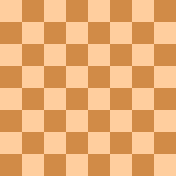Stalemate facts for kids
Stalemate is a cool situation in chess where the game ends in a draw. It happens when a player whose turn it is to move has no legal moves left. But here's the catch: their king is NOT in check. It's like being stuck with nowhere to go!
| a | b | c | d | e | f | g | h | ||
| 8 |

|
8 | |||||||
| 7 | 7 | ||||||||
| 6 | 6 | ||||||||
| 5 | 5 | ||||||||
| 4 | 4 | ||||||||
| 3 | 3 | ||||||||
| 2 | 2 | ||||||||
| 1 | 1 | ||||||||
| a | b | c | d | e | f | g | h | ||
In the diagram, it's Black's turn to move. Black's king is on the board. However, Black has no pieces that can move. Also, the Black king cannot move to any square without going into check. Since the Black king is not currently in check, this position is a stalemate.
Contents
What is a Stalemate in Chess?
A stalemate means the game is a draw. This means neither player wins or loses. It's like a tie! Even though a player might have many pieces, if the other player is stalemated, the game is still a draw.
Why Stalemate is Important
Stalemate doesn't happen very often in the middle of a chess game. But it's super important in the endgame. This is when there are only a few pieces left on the board. Players often try to force a stalemate if they are losing. This helps them avoid a loss and get a draw instead.
For example, if one player has a king and a rook, and the other player only has a king, the player with the rook usually wins. But if the player with only the king can get into a stalemate position, they can save the game!
History of the Stalemate Rule
The idea of stalemate being a draw took a long time to become a rule. In older versions of chess, like shatranj from ancient Persia, stalemate was different. Sometimes, the player who caused the stalemate would even win!
Over many years, chess rules changed. By the early 1800s, it was finally agreed that stalemate should always be a draw. A British chess master named J.H. Sarratt helped make this rule official in London in 1807.
Stalemate in Everyday Life
The word "stalemate" isn't just for chess! People use it to describe situations outside of the game too. When you hear about a "stalemate" in other areas, it means things are stuck.
Examples of Stalemate
- Bargaining: Imagine two friends trying to decide what movie to watch. If neither can agree, and they can't move forward, that's a stalemate.
- Politics: Sometimes, different political groups can't agree on a new law. If they are completely stuck, it's called a political stalemate.
- General Life: If you and your parents can't agree on something, and no one can find a way to move forward, you might be in a stalemate.
Using "stalemate" in these ways is called figurative language. It's like using a metaphor to explain that a situation is stuck, just like a king in chess with no legal moves.
See also
 In Spanish: Rey ahogado para niños
In Spanish: Rey ahogado para niños

